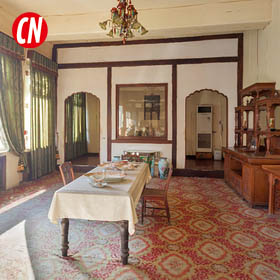The Palace Museum - Hall of Martial Valor
Wuying Palace
Wuying Hall and Wenhua Hall are located on the east and west sides of the Three Main Halls. In Ming Dynasty, the Wuying Hall was a fasting palace before the emperor's participation in sacrificial activities, in the Qing Dynasty it was changed to works for books, now the Wuying Hall was opened as a calligraphy and painting gallery.
To the east and west sides of the Three Main Halls of the Forbidden City, there are two complexes, the Hall of Martial Valor (Wuying Hall 武英殿) and the Hall of Literary Brilliance (Wenhua Hall 文华殿), which serve as the left and right wings to the outer court.
Along the Inner Golden Water River (Inner Jinshui River 内金水河) in Taihemen Square to the west, you can see the main gate of the Wuying Hall: Wuying Gate. Similar to the Taihe Gate, there are three parallel stone bridges over the river outside the Wuying Gate. Through the Wuying Gate, the main building of the area, the Wuying Hall, comes into view.
Wuying Hall is a single-saddle-roofed building of five rooms wide, which was not very large in scale. It was used as The Hall for Abstinence in the early Ming Dynasty before the emperor took part in important rituals. In the late Ming Dynasty, Li Zicheng, the leader of the peasant rebellion, occupied the Forbidden City and was crowned emperor in a ceremony held in Wuying Hall before he retreated from Beijing. In the Kangxi years of the Qing Dynasty, the Hall of Wuying was changed into a book works, a special book repair institution within the Palace. Today, the Wuying Hall is set aside as a museum of calligraphy and painting within the Forbidden City, showing visitors the fine calligraphy and painting relics collected by the Forbidden City over the ages.
If you go north out of the Wuying Hall, you will arrive at the Hall of Mental Cultivation (Yangxin Hall 养心殿) , where the eight Qing emperors, such as Yongzheng and Qianlong, lived:

The Palace Museum - Hall of Mental Cultivation
Yangxin Palace
Yangxin Hall was just an ordinary hall in the Forbidden City, the Yongzheng Emperor converted as a bedchamber, followed by his eight Qing successors. During Tongzhi and Guangxu period, Empress Dawagers Cixi and Ci'an reigned behind a curtain here, controlling the Qing regime for decades.
The Palace Museum Series
- The Palace Museum / The Forbidden City
- The Palace Museum - Meridian Gate And Square
- The Palace Museum - Gate of Supreme Harmony And Square
- The Palace Museum - Three Halls of the Outer Court
- The Palace Museum - Three Palaces of the Inner Court
- The Palace Museum – Hall of Martial Valor
- The Palace Museum - Hall of Mental Cultivation
- The Palace Museum - Hall for Ancestral Worship / The Clock Gallery
- The Palace Museum - Palace of Tranquil Longevity Area / The Treasure Gallery
- The Palace Museum - Six Palaces of West Road
- The Palace Museum - Six Palaces of East Road
- The Palace Museum - The Imperial Garden
- The Palace Museum - Gate of Divine Prowess
- The Palace Museum - The Corner Tower And Moat
Tags:
Related
Arakurayama Sengen Park360
A Classic Fuji ViewGardens By The Bay360
Flowers and Giant Trees.Avenue des Champs-Elysees360
A World Famous Commercial AvenueMatthias Church360
The legendary King of HungaryOlympiapark Munich360
Venue of the 20th Summer OlympicsGreat Wall At Badaling360
Northern Gate of Capital BeijingRoyal Palace Of Brussels360
Official Belgian Royal PalaceThe Bund360
Shanghai's Golden YearsMaria-Theresien-Platz360
Only Female Ruler of the HabsburgsKoyasan Daimon Gate360
Whole Mountain Main EntranceWiener Musikverein360
The Celebrated New Year's ConcertSt. Peter's Church360
Magnificent Sculptures and Murals




























No comments yet, post the first one!